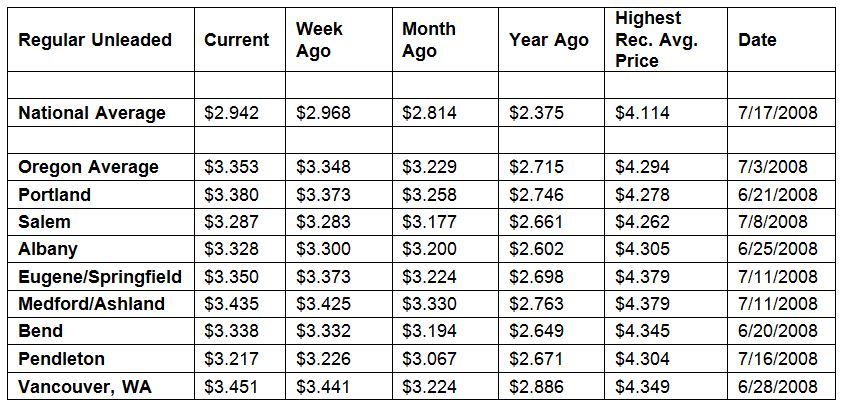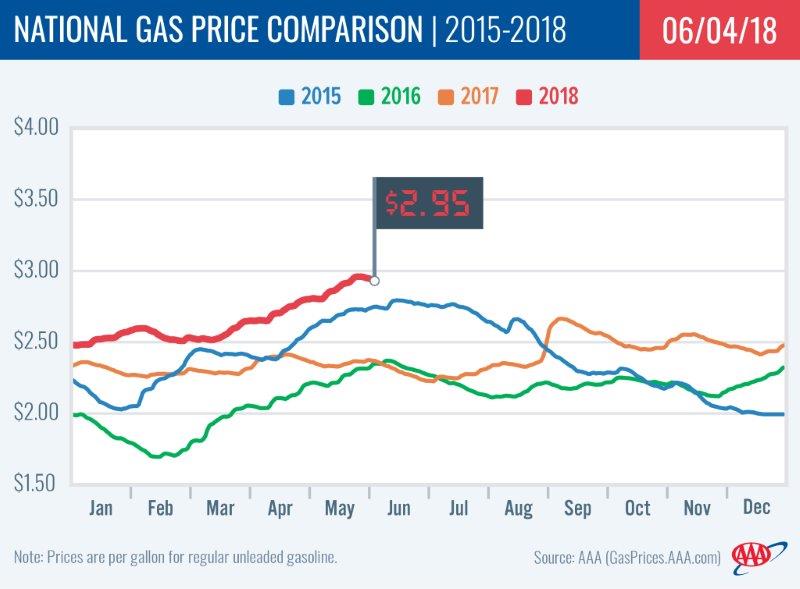PORTLAND, Ore., – For the first time since mid-March, the national average for regular is lower week-over-week, due in part to slipping crude oil prices and plentiful supplies. For the week, the national average for regular drops three cents to $2.94 a gallon. The Oregon average adds half a cent to $3.35. Both averages remain at their highest prices since the fall of 2014.
Crude oil prices climbed to $73 per barrel last month, the highest prices since November 2014, but are back down around $65 per barrel this week. “The lower crude oil prices will put some downward pressure on pump prices, but significant drops aren’t expected this summer,” says Marie Dodds, public affairs director for AAA Oregon/Idaho.
Demand for gasoline continues to be strong, although the latest U.S. Energy Information Administration (EIA) report shows demand running slightly below (100,000 b/d less) the same week last year.
Oregon is one of 14 states reporting week-over-week increases. The largest increases are in Montana (+3 cents) and South Dakota (+3 cents). Michigan (-12 cents) and Ohio (-11 cents) report the largest weekly decreases. This week 15 states have averages at or above $3 a gallon, down from 17 a week ago.
All 50 states and the District of Columbia have higher prices than one month ago. The national average is 13 cents more and the Oregon average is 12 cents more than a month ago. Oregon has the 31st-largest monthly increase in the country. Colorado (+23 cents) and North Dakota (+22 cents) have the largest monthly gains.
The West Coast still has the most expensive gas prices in the nation. California tops the list again for the sixth week in a row, followed by Hawaii, Washington, Alaska, Oregon and Nevada. Oregon is fifth most expensive for the second week in a row. Gas prices in the region are fairly flat, with Alaska and Arizona seeing the largest increases at less than two cents each.
| Rank | Region | Price on 6/5/18 | |
| 1 | California | $3.73 | |
| 2 | Hawaii | $3.71 | |
| 3 | Washington | $3.47 | |
| 4 | Alaska | $3.41 | |
| 5 | Oregon | $3.35 | |
| 6 | Nevada | $3.33 | |
| 7 | Idaho | $3.19 | |
| 8 | Connecticut | $3.15 | |
| 9 | Utah | $3.14 | |
| 10 | Pennsylvania | $3.10 |
According to data from the EIA for the week ending on May 25, inventories of gasoline on the West Coast climbed by an astonishing 1 million bbl to 31.3 million bbl. When compared to a year ago, levels are up more than 3 million bbl and could contribute to price stabilization in coming weeks.
The nation’s cheapest markets are South Carolina ($2.62) and Mississippi ($2.64). For the 44th week in a row, no states have an average below $2.
Drivers in all 50 states and the District of Columbia are paying are paying more than a year ago to fill up. The national average is 57 cents more and the Oregon average is 64 cents more than a year ago. This is the 7th-largest yearly increase in the country. Arizona has the greatest year-over-year increase of 75 cents; New Mexico is second at 69 cents; and Illinois is third at 68 cents.
Oil Market Dynamics
Just two weeks ago, crude oil prices were at three-and-a-half year highs of about $73 per barrel. Crude prices tumbled a week-and-a-half ago after reports that OPEC might ease its production cuts. Prices continued to move lower late last week because the dollar gained amid news of continued growth in the total number of jobs across the country. Earlier in the week, crude prices rose briefly after EIA’s weekly petroleum report showed that crude inventories fell by 3.6 million bbl.
Last week, EIA also released final crude production rates for March 2018, revealing that it hit a record-breaking 10.47 million b/d. The rate increased by 223,000 b/d from February 2018. Continued growth in crude production may reduce crude prices as it signals that supply is growing alongside strong global crude demand.
This continued crude production growth will put another spotlight on OPEC’s supply reduction agreement with its partners, which has been in place since the beginning of 2017. The agreement, which includes production from Russia, is set to expire at the end of 2018. However, member countries of OPEC and Russia have been discussing potentially easing supply limits ahead of the agreement’s dissolution at the end of the year. If the cartel and its partners decide to increase crude output, they will likely announce the decision on June 22 at the next OPEC meeting in Vienna, Austria.
Additionally, Baker Hughes, Inc. reported that the U.S. added two oil rigs last week, bringing the total to 861. The total is up by 128 rigs when compared to last year at this time.
At the close of Friday’s formal trading session on the NYMEX, WTI dropped $1.23 to settle at $65.81. At the close of Monday’s formal trading session on the NYMEX, WTI dropped $1.06 to settle at $64.75. Today crude is trading around $66, compared to $67 a week ago. Crude prices are down about seven percent in the last month and are about $17 more per barrel than a year ago.
Drivers can find current gas prices along their route with the free AAA Mobile app for iPhone, iPad and Android. The app can also be used to map a route, find discounts, book a hotel and access AAA roadside assistance. Learn more at AAA.com/mobile.
Diesel
For the week, the national average remains at $3.21 a gallon. Oregon’s average adds a penny to $3.43. A year ago the national average for diesel was $2.51 and the Oregon average was $2.68.
Find current fuel prices at GasPrices.AAA.com.
AAA news releases, high resolution images, broadcast-quality video, fact sheets and podcasts are available on the AAA NewsRoom at NewsRoom.AAA.com.
Fuel prices are updated daily at AAA’s Daily Fuel Gauge at AAA Gas Prices. For more info go www.AAA.com. AAA Oregon/Idaho provides more than 800,000 members with travel, insurance, financial and automotive-related services, and is an affiliate of AAA National, serving more than 58 million motorists in North America.



